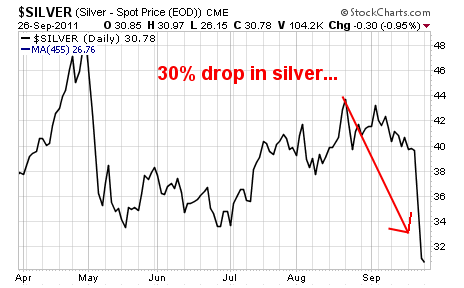I think the silver margin increase (and the corresponding drop in silver’s price) [instituted by China] spells out in big bold letters – a once every century GLOBAL SHIFT IN THE WORLD’S CENTER OF POWER, TRADE AND INFLUENCE. I hope you’re paying attention – this is history in the making. [Let me explain.] Words: 560
bold letters – a once every century GLOBAL SHIFT IN THE WORLD’S CENTER OF POWER, TRADE AND INFLUENCE. I hope you’re paying attention – this is history in the making. [Let me explain.] Words: 560
So says Kevin McElroy (www.wyattresearch.com) in edited excerpts from an article* which Lorimer Wilson, editor of www.munKNEE.com (Your Key to Making Money!), has further edited ([ ]), abridged (…) and reformatted below for the sake of clarity and brevity to ensure a fast and easy read. The author’s views and conclusions are unaltered and no personal comments have been included to maintain the integrity of the original article. Please note that this paragraph must be included in any article re-posting to avoid copyright infringement.
McElroy goes on to explain, in part:
While gold is currently about 15% off its highs of $1,900 – silver fell about 30% from peak to trough – in less than a month…[with] the bulk of the drop occurring in just the last week – from $40 down to below $30. So what happened to precipitate such a dramatic fall?
[As the chart below shows] these types of price swings are NOT rare at all for silver. It’s consistently the most erratic and volatile asset out there. That doesn’t mean it’s not a good long-term holding for commodity investors – it just means that it’s a rocky ride – and basically that just means that silver is subject to a variety of catalysts that can have substantial short term price effects.
One of the biggest catalysts for ANY commodity or asset is a margin increase. If you don’t know what margin is – it’s basically a way to buy (or sell) stocks or commodities with money borrowed from a broker. You post a small part of the purchase price, and you can control more shares or units. If the price rises, you can cash out for a much bigger profit but if the trade goes against you, your broker can call your margin (a margin call) and possibly ask you to put up more capital to cover the loss. [As such,] it is a great way to make or lose much more money than with regular buying and selling.
Who in the world is currently reading this article along with you? Click here to find out.
Each exchange has its own margin requirements – and the exchange can raise or lower these requirements in order to stimulate buying or selling. That’s an oversimplification, but exchanges try to walk the line between creating lots of liquidity (by keeping margins low) and completely wiping out brokers and traders (by moving margins higher). When an asset price rises too quickly, most exchanges will nip that asset in the bud with a margin requirement increase. Doing so tends to encourage selling – because when an asset rises quickly, it’s likely that most if not all of that asset’s buyers are already leveraged to the hilt. Asking them to post more margin basically forces them to sell…
Back in late April, the Chicago Mercantile Exchange raised margin requirements by 16% on silver that precipitated the huge selloff. This past week the Shanghai Gold Exchange raised margins 20% which has HUGE ramifications for not just the precious metals market – but for every market. While it means another great entry point for long term investors the larger consequence is that the world’s center of power, trade and influence are all shifting East – to China. That kind of move is huge.
 munKNEE.com Your Key to Making Money
munKNEE.com Your Key to Making Money